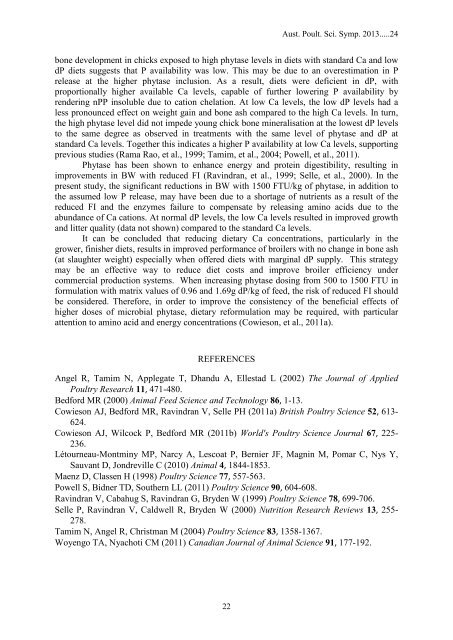APSS 2013 Proceedings - The University of Sydney
APSS 2013 Proceedings - The University of Sydney
APSS 2013 Proceedings - The University of Sydney
Create successful ePaper yourself
Turn your PDF publications into a flip-book with our unique Google optimized e-Paper software.
Aust. Poult. Sci. Symp. <strong>2013</strong>.....24<br />
bone development in chicks exposed to high phytase levels in diets with standard Ca and low<br />
dP diets suggests that P availability was low. This may be due to an overestimation in P<br />
release at the higher phytase inclusion. As a result, diets were deficient in dP, with<br />
proportionally higher available Ca levels, capable <strong>of</strong> further lowering P availability by<br />
rendering nPP insoluble due to cation chelation. At low Ca levels, the low dP levels had a<br />
less pronounced effect on weight gain and bone ash compared to the high Ca levels. In turn,<br />
the high phytase level did not impede young chick bone mineralisation at the lowest dP levels<br />
to the same degree as observed in treatments with the same level <strong>of</strong> phytase and dP at<br />
standard Ca levels. Together this indicates a higher P availability at low Ca levels, supporting<br />
previous studies (Rama Rao, et al., 1999; Tamim, et al., 2004; Powell, et al., 2011).<br />
Phytase has been shown to enhance energy and protein digestibility, resulting in<br />
improvements in BW with reduced FI (Ravindran, et al., 1999; Selle, et al., 2000). In the<br />
present study, the significant reductions in BW with 1500 FTU/kg <strong>of</strong> phytase, in addition to<br />
the assumed low P release, may have been due to a shortage <strong>of</strong> nutrients as a result <strong>of</strong> the<br />
reduced FI and the enzymes failure to compensate by releasing amino acids due to the<br />
abundance <strong>of</strong> Ca cations. At normal dP levels, the low Ca levels resulted in improved growth<br />
and litter quality (data not shown) compared to the standard Ca levels.<br />
It can be concluded that reducing dietary Ca concentrations, particularly in the<br />
grower, finisher diets, results in improved performance <strong>of</strong> broilers with no change in bone ash<br />
(at slaughter weight) especially when <strong>of</strong>fered diets with marginal dP supply. This strategy<br />
may be an effective way to reduce diet costs and improve broiler efficiency under<br />
commercial production systems. When increasing phytase dosing from 500 to 1500 FTU in<br />
formulation with matrix values <strong>of</strong> 0.96 and 1.69g dP/kg <strong>of</strong> feed, the risk <strong>of</strong> reduced FI should<br />
be considered. <strong>The</strong>refore, in order to improve the consistency <strong>of</strong> the beneficial effects <strong>of</strong><br />
higher doses <strong>of</strong> microbial phytase, dietary reformulation may be required, with particular<br />
attention to amino acid and energy concentrations (Cowieson, et al., 2011a).<br />
REFERENCES<br />
Angel R, Tamim N, Applegate T, Dhandu A, Ellestad L (2002) <strong>The</strong> Journal <strong>of</strong> Applied<br />
Poultry Research 11, 471-480.<br />
Bedford MR (2000) Animal Feed Science and Technology 86, 1-13.<br />
Cowieson AJ, Bedford MR, Ravindran V, Selle PH (2011a) British Poultry Science 52, 613-<br />
624.<br />
Cowieson AJ, Wilcock P, Bedford MR (2011b) World's Poultry Science Journal 67, 225-<br />
236.<br />
Létourneau-Montminy MP, Narcy A, Lescoat P, Bernier JF, Magnin M, Pomar C, Nys Y,<br />
Sauvant D, Jondreville C (2010) Animal 4, 1844-1853.<br />
Maenz D, Classen H (1998) Poultry Science 77, 557-563.<br />
Powell S, Bidner TD, Southern LL (2011) Poultry Science 90, 604-608.<br />
Ravindran V, Cabahug S, Ravindran G, Bryden W (1999) Poultry Science 78, 699-706.<br />
Selle P, Ravindran V, Caldwell R, Bryden W (2000) Nutrition Research Reviews 13, 255-<br />
278.<br />
Tamim N, Angel R, Christman M (2004) Poultry Science 83, 1358-1367.<br />
Woyengo TA, Nyachoti CM (2011) Canadian Journal <strong>of</strong> Animal Science 91, 177-192.<br />
22
















